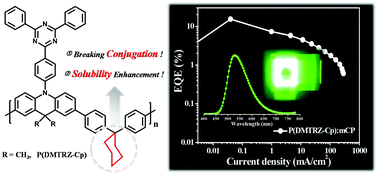Solution-processed thermally activated delayed fluorescence organic light-emitting diodes using a new polymeric emitter containing non-conjugated cyclohexane units†
Abstract
The importance of thermally activated delayed fluorescence (TADF) materials in organic light-emitting diode (OLED) applications continues to grow as a consequence of their unique properties and excellent performance. Herein, a new green-emitting TADF polymer, P(DMTRZ-Cp), for solution-processable OLEDs was designed and synthesized based on the structure of DMAC-TRZ that shows typical TADF characteristics as a small molecule. The 1,1-diphenylcyclohexane (Cp) moiety introduced into the structure of the polymeric emitter not only acts as a linker between the conjugated monomeric units, but also helps enhancing solubility while disconnecting conjugation along the polymer backbones. P(DMTRZ-Cp) exhibits obvious TADF features such as a small energy gap (0.023 eV) between its lowest singlet and triplet excited states, and obvious delayed photoluminescence (PL) decay behavior. Moreover, this new polymeric emitter exhibits high PL quantum yield over 90% in the film state. By applying solution-processed TADF-OLED devices, P(DMTRZ-Cp) exhibited the maximum external quantum efficiency of up to 15.4% with green emission. As far as we know, this is the first report to introduce a non-conjugated linker, Cp, in the main-chain type polymeric emitter structure that presents TADF characteristics. The Cp linker is considered to be a promising moiety for the development of solution-processable polymeric emitters with high efficiencies.



 Please wait while we load your content...
Please wait while we load your content...